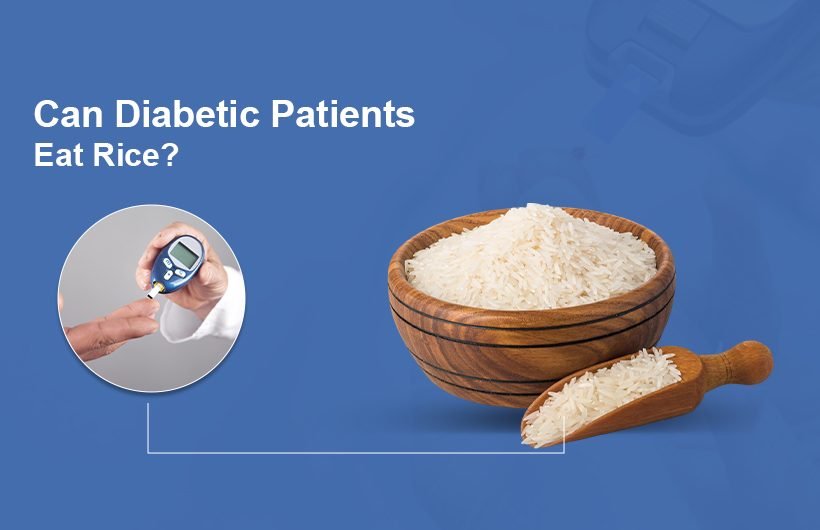Rice is a staple food for billions of people worldwide, forming the foundation of many traditional diets. However, for diabetic patients, managing carbohydrate intake is crucial to controlling blood sugar levels. This leads to a common question: Can diabetic patients eat rice? While rice is often considered high in carbohydrates, making informed choices about the type of rice and how it is consumed can help diabetics enjoy it without negatively impacting their health.
In this article, we will explore how rice affects blood sugar levels, the best types of rice for diabetics, healthy ways to incorporate rice into a diabetic diet, and alternative grains that can be beneficial.
Understanding Rice and Its Impact on Blood Sugar
Rice is a carbohydrate-rich grain that serves as a primary energy source for many populations. However, different types of rice have varying effects on blood sugar, primarily due to their Glycemic Index (GI), which measures how quickly a food raises blood glucose levels.
The Glycemic Index of Rice
- White rice has a high GI (70-90), meaning it rapidly increases blood sugar levels.
- Brown rice has a medium GI (50-60) due to its fibre content, which slows digestion.
- Basmati rice has a lower GI (50-58) compared to regular white rice, making it a better option.
- Black rice, red rice, and wild rice have even lower GI values and higher fibre content, which can help regulate blood sugar.
White Rice vs. Brown Rice vs. Basmati Rice
- White rice is highly processed, and stripped of fiber and essential nutrients, making it less ideal for diabetics.
- Brown rice retains its bran and germ layers, providing fibre that aids in blood sugar control.
- Basmati rice, particularly whole grain or brown basmati, has a lower GI and is a better choice for diabetics.
Can Diabetic Patients Eat Rice?
Yes, diabetic patients can eat rice, but it must be done in moderation with mindful choices. Here are some important considerations:
Portion Control & Balanced Meals
- Limit rice intake to small portions (1/2 cup to 1 cup per meal).
- Combine rice with high-fibre vegetables, lean proteins, and healthy fats to slow down glucose absorption.
- Avoid eating rice alone; instead, balance it with legumes, nuts, or healthy oils.
How to Minimize the Blood Sugar Impact
- Parboiled rice has a lower GI than regular white rice.
- Cooling and reheating rice (e.g., in meal prep) can increase resistant starch, which helps control blood sugar.
- Adding vinegar, lemon juice, or turmeric to rice dishes can further slow glucose spikes.
Which Rice Is Good for Diabetic Patients?
Diabetics should opt for low-GI rice varieties that provide fibre and nutrients without spiking blood sugar levels. Some of the best options include:
1. Brown Rice
- Rich in fibre and B vitamins.
- Slower digestion helps prevent rapid sugar spikes.
2. Basmati Rice (Especially Whole Grain Basmati)
- Lower GI than regular white rice.
- Contains more fibre and protein than standard rice.
3. Black Rice (Forbidden Rice)
- Packed with antioxidants, fibre, and essential nutrients.
- GI is much lower than white rice, making it a good choice for diabetics.
4. Red Rice
- High in anthocyanins, which help reduce inflammation and improve blood sugar control.
- Rich in fibre and protein.
5. Wild Rice
- Technically grass and wild rice have a lower carbohydrate content than regular rice.
- High in fibre, protein, and essential minerals.
Healthy Ways to Eat Rice with Diabetes
While rice is not off-limits for diabetics, making smart choices in preparation and consumption can make a big difference.
Portion Control Tips
- Stick to 1/2 cup of cooked rice per meal.
- Use smaller bowls to help control portion sizes.
- Mix rice with fibre-rich vegetables to slow down digestion.
Pairing Rice with Nutrient-Dense Foods
- Add vegetables: Spinach, broccoli, bell peppers, and carrots.
- Include lean proteins: Chicken, tofu, fish, or legumes.
- Healthy fats: Olive oil, nuts, seeds, or avocados can slow glucose absorption.
Cooking Techniques to Lower GI
- Soak rice before cooking to reduce its GI.
- Cook and cool rice before eating to increase resistant starch.
- Combine rice with lentils or beans for a protein boost.
Alternatives to Rice for Diabetics
If you’re looking to reduce rice consumption or explore healthier alternatives, consider the following low-GI grains:
1. Quinoa
- A complete protein with all nine essential amino acids.
- High in fibre and has a low GI, making it a great rice substitute.
2. Cauliflower Rice
- A low-carb alternative that mimics the texture of rice.
- High in fibre, vitamins, and antioxidants.
3. Barley
- Rich in beta-glucan fibre, which slows glucose absorption.
- Provides a chewy texture and nutty flavour.
4. Bulgur Wheat
- A great source of fibre and protein.
- Low GI and helps in blood sugar management.
5. Lentils & Legumes
- Low in carbohydrates but high in protein and fibre.
- Help stabilize blood sugar when used as a rice replacement.
Conclusion
Diabetic patients do not have to completely avoid rice, but making the right choices is essential for managing blood sugar levels. Opting for low-GI rice varieties, controlling portion sizes, and pairing rice with fibre, protein, and healthy fats can help minimize its impact on glucose levels. Additionally, exploring healthy rice alternatives like quinoa, cauliflower rice, and lentils can provide even better nutrition while keeping blood sugar stable.
For personalized diabetes management and expert guidance, consult Dr. Moxit Shah, a Best Endocrinologist in Ahmedabad. With his specialized expertise, he helps patients make informed dietary choices and manage diabetes effectively.
If you’re a diabetic and enjoy rice, try incorporating some of these strategies into your diet and see what works best for you. Have you found a good way to enjoy rice while managing diabetes? Share your experience in the comments below!







